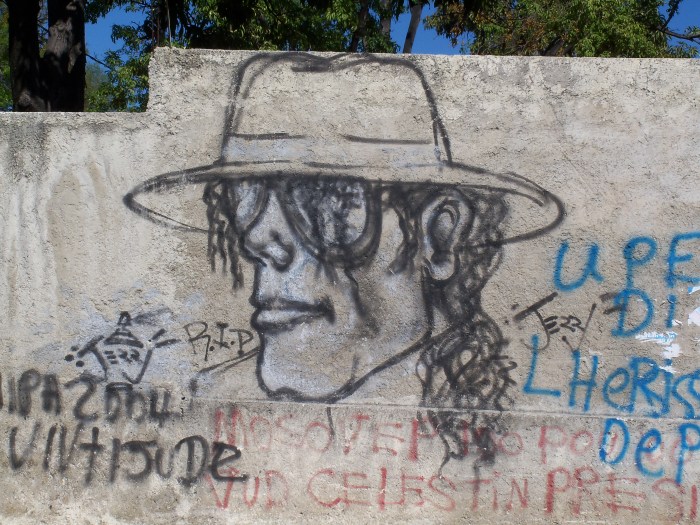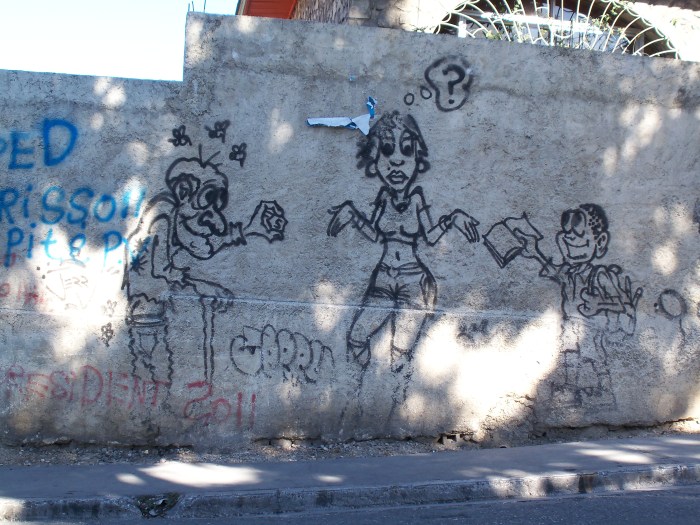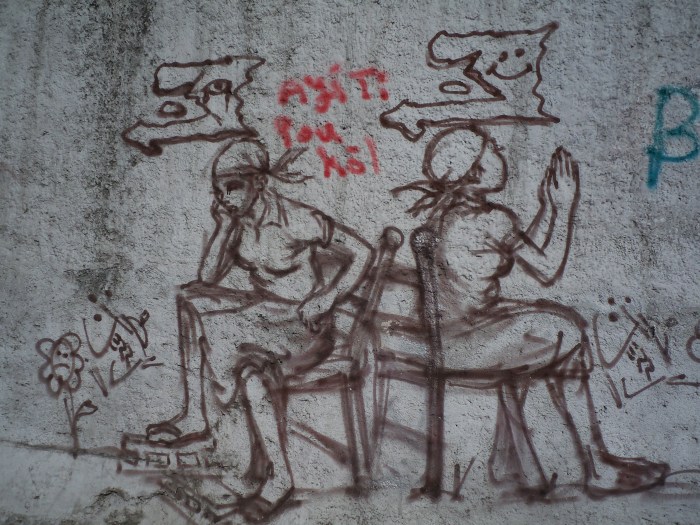While we were still living in Port-au-Prince, I posted photos of Haitian street art—specifically the graffiti of Jerry Rosembert Moise, who paints the story of post-earthquake Haiti on the walls of his city. (To read this post, click here.)
Though I didn’t find the time to do a second post on Jerry’s brilliant renderings of street grief before we left the city, I did manage to snap of few photos of Jerry’s work before we moved home to the US–so I could share them in a later post—
Today then—let’s flash back to Port-au-Prince, as I pass along five facts about Haitian street art as illustrated by the graffiti of Jerry—the sadness he paints in a city that’s suffered enormous loss:
1. Haiti has a long tradition of political graffiti, one that Jerry claims he’s not a part of and at the very least one he’s shifting the focus away from.
Political graffiti is virtually everywhere in Haiti’s capital—the names of presidential candidates literally littering the city in ink.
However, Jerry’s work—though not overtly political—promotes national pride in the face of never-ending adversity.
This is an example of Jerry’s softened political message, a saddened nation weeping silently as a muted child waves Haiti’s bleeding flag of non-surrender.
2. In fact, Jerry would adjust the volume of Haiti’s silent weeping, by gaining international notoriety for himself, when he painted a portrait of the newly-deceased Michael Jackson that gained him a spot on the New York Times front page.
Below is a photo of Jerry’s graffitied portrait of Jackson, one I took during my last afternoon in Haiti:
This recognition by the international media gave Jerry a megaphone with which to shout a formerly muted message about the challenges faced by his country in its post-earthquake devastation.
3. Thus, Jerry began loudly broadcasting graffitied messages about the social injustices endured by his people—one of which focuses on the nation’s need for educational reform.
Think of it this way—Haiti has long struggled with democracy, especially since the days of the Duvalier dictatorships of Papa Doc and Baby Doc. (To read my interview with Baby Doc Duvalier click here.) And the success of democracy depends on an educated citizenry—a massive challenge in a country that struggles with an illiteracy rate approaching 50%.
Among the messages Jerry broadcasts via his graffiti is one about the educational choices the country must make to assist itself in recovery and the choices the international community faces in its effort to help Haiti:
Not only does work like this speak to the issue of education, but graffiti itself is a powerful communication tool in a country with such low literacy rates—where people read images more easily than they do words.
4. However, Haiti is a nation with deep faith, and Jerry’s work would shift the usual political focus of Haitian graffiti to a spiritual one more dependent on prayer than indifference and passive grief:
For centuries, Haiti had struggled to locate hope amidst epic kinds of crisis. In this piece, at least, Jerry suggests faith is the only avenue to grace—that one can only be saved in the context of grace greater than the country’s most current disaster.
5. Finally, Haiti is also a nation facing a healthcare crisis in the form of cholera, an epidemic that, according to the Ministry of Public Health and Population’s latest estimates, has sickened more than 320,000 and killed more than 5,300—a fight Jerry has also spoken to, recently joining the work of international NGOs, painting murals on the walls surrounding latrines in some of Haiti’s relief camps:
These basic hygiene reminders are becoming even more important, as Haiti enters its rainy season—a time when cholera, a water-borne illness, is likely to spread in these tented and tarped communities.
So–this is a snapshot of Haitian street art as imaged by one graffiti artist, a snapshot seen through the eyes of this Kentucky artist, after nearly a year of living in Haiti and falling deeply in love, not only with the Haitian people, but also with the art of a country challenged still by earthquake recovery and now by a cholera epidemic that continues to kill by the thousands.
A more thorough look at street art in Haiti could not ignore the amazingly painted tap-taps that serve as public transportation in and around Port-au-Prince, as well as the folk art paintings sold on streets all over the city. (To read my post on the latter, click here.)
Haiti gave me a most amazing gift—the ability to call its hills my home for nearly 12 months and the opportunity to love a country that is desperate but enduring, daunting but unrelenting—determined to survive at all costs.
It is this spirit of steadfast beauty and determination that Haitian street art images—bodies broken but hearts enduring, steady and steep as the mountains that surround Port-au-Prince on the sunniest and most hopeful of days.























The language of visual art is in someways even more powerful than the power of words. For words require a certain knowledge base. Visual arts defy cultural and educational boundaries. It is a beautiful thing that Jerry’s visual words are being spread! Nothing is more evocative then a message direct from the source! He is lucky to have crossed paths with you!!
LikeLike
Oh, I feel the opposite is true! I feel fortunate to have seen and enjoyed his work. It is amazing! But, you are so correct–messages that bi-pass language are much more powerful and profound–have massive impact! Thanks for these reminders!!! Thank you, thank you, Steve!
LikeLike
His art/graffiti is very powerful. Thank you for sharing it with us.
LikeLike
You are so welcome, Robin! Thanks for taking a look! Hope you are doing well!
LikeLike
Beautiful post–I love the images…they speak of place, of condition…of hope.
blessings
jane
LikeLike
Oh, I’m so glad you enjoyed this one, Jane! Jerry is an amazing artist with an even more amazing message! Thanks for reading, my friend!
LikeLike
Pingback: Haitian Street Art: 5 Graffitied Facts | reinventing the event horizon -Political Fund USA
Very dynamic art shown here…thanks for this post of his work.
LikeLike
Glad you enjoyed it, Charles!
LikeLike
I can’t believe he painted that first hand-washing mural in on 20 minutes! I love graffiti art — there is lots of beautiful staff here in JHB and I need to do a post about it one of these days. Very interesting post – thank you.
LikeLike
How fun it wold be to see the graffiti there in JHB! Hope you do that soon! But, I know, is this guy not amazing!
LikeLike
Wow…I wish the graffiti around these parts was as artistic as the pieces you’ve posted here. This is good stuff!
LikeLike
I thought it was pretty fun myself! Jerry is an amazing artist! Glad you enjoyed his work!
LikeLike
Thank you for sharing more of Jerry’s beautiful art with us, Kathy!
Hugs,
Wendy
LikeLike
Ah, yes, Wendy, you remember my other post about Jerry! He is an amazing artist! Thank you!
LikeLike
Interesting insight into Haiti.
Thanks
LikeLike
Thanks so much for reading and taking the time to comment. I hope you’ll come back often. It was great having you!
LikeLike
Pingback: Jerry, the Amazing Haitian Street Artist | breezyinhaiti2011
hello Kathryn this is Jerry , thank you for everything …
m.jerryrosembert@yahoo.fr
go to google.com then type jerry graffiti haiti you’ll see many stuff about me
thx
J
LikeLike
Jerry–I am so thrilled to hear from you! You are an amazing artist–truly! Wish we could have met during the year I lived in Haiti. However, I can’t tell you how much your work spoke to me–how wonderful to see it all over Petion-ville! It fed something in my soul! And so many people I know in Haiti feel the same way about it! Blessings to you! Hope you will stay in touch!
LikeLike